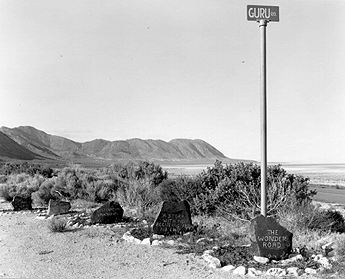| You are driving through Gerlach, Nevada, a small town 100 miles north of Reno on the edge of the Black Rock Desert. You take the fork and bear right onto Route 34 heading north towards the playa entrances when you notice a road sign off to the left about a mile out of town. You slow down as a rock pillar erected without mortar or cement comes into view. White letters attract your eyes and you stop to read, scratched in the ruddy stone: "Dooby Avenue West," and "Whatever You Think About This Road Remember The Price Is Right." Your curiosity piqued, you decide you are in no hurry, and you might as well see what there is to see, and so you drive up the slight crest to find a target-shaped pattern with beckoning rocks covered with words. "Ground Zero," one rock in the middle states. As you travel further, you find rock after rock etched with names and commentary: various truths and observations of life, arranged to elicit thought and provoke contemplation. When you come out the other side, you are glad you took the time. You have just experienced Dooby Avenue, an incredible monument of art, which I undertook to help restore the day before Easter, 2003. |
 Peter Goin |
|
My involvement with Dooby Avenue began in 2000, when I first moved to Northern Nevada. The artists, DeWayne "Dooby" Williams and his son, DeWayne II, are related to Tom Williams, who set me up as caretaker at the Fly Ranch my first winter here. The Williams have lived in the Black Rock area for several generations, and Dooby himself was born less than a mile from Black Rock Station, where I live. I became friends with the Williams family, and became aware of Dooby's art installation. It was built on BLM land just before the 3-mile playa entrance outside of Gerlach between 1973 and 1993. It started when Dooby chiseled his name onto a rock, much like the pioneers who passed through this area 100 years earlier. Then he added rocks with names of other local inhabitants (perhaps all of them). Then it blossomed into a series of expressive installations. "Ground Zero," the first, depicts an atomic bomb blast in different colored rocks. Dooby was in Japan as a US Marine 2 weeks after atomic bombs were dropped, and wanted his piece to serve as a reminder that it should never happen again. There is the "Elvis" pillar, perches for birds to "decorate" the pillars of rocks with the white streaks of their excrement, "The Sagebrush Network" TV station, and "Aphrodite's Grove." A tipi made of willow branches bears the rock-carved instruction "Leave Your Hang-Ups Here," and many different things have collected, suspended and dangling from it. Sit on the chair inside, and discover you are looking down into a grave at a rock inscribed, "Are You Ready For Eternity?" Over the years that Dooby worked on it, the Avenue developed and matured.
|
|
|
|